Drip irrigation for corn: A case study comparing sprinkler vs. drip methods in corn farming
Updated: 21. March 2025
Sprinklers are currently the most widely used irrigation technology in Romania when it comes to corn cultivation. However, increasing water stress and growing energy prices have pushed farmers to consider more economical alternatives, with precision irrigation being one of them. We visited an agricultural business in Romania, Lux Com SRL, which applied both irrigation methods to its corn fields last season. Mitran Marian, agricultural engineer at Lux Com, agreed to share his observations and feedback.
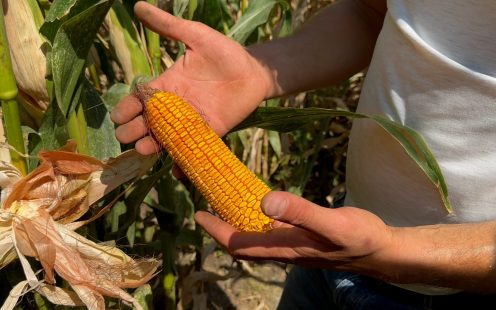.jpg)
Importance of water management in corn cultivation
Corn farming is a cornerstone of global agriculture, playing a crucial role in feeding the world’s ever-growing population. However, corn is a water-intensive crop, making efficient agricultural water management essential for successful cultivation. Traditional irrigation methods, such as flood or overhead irrigation, often lead to significant water wastage due to evaporation and runoff. This not only increases operating costs for farmers but also has detrimental environmental impacts, such as depleting groundwater resources and contributing to water pollution.
As climate change continues to alter weather patterns, the need for effective water management in agriculture has become even more critical. Drip or trickle irrigation is a technology that supplies water and nutrients directly to the root zone of plants, ensuring they receive the right amount at the right time.
Overview of irrigation systems for corn
Maintaining optimal soil moisture levels is crucial in corn farming, as uniform moisture distribution enhances plant growth and maximizes yield potential. Maize farmers have several irrigation methods at their disposal, each with its own set of advantages and challenges.
Conventional irrigation methods, such as linear or center pivot irrigation, are commonly used across Europe but come with higher energy and water consumption. Compared to these technologies, drip or trickle irrigation systems stand out for their efficiency and precision. Drip irrigation delivers water directly to the roots of plants, significantly reducing evaporation and runoff.
The choice of the best irrigation system depends on various factors, including water availability, soil type and crop requirements. Understanding these factors is crucial for farmers to optimize their irrigation practices and achieve better yields.
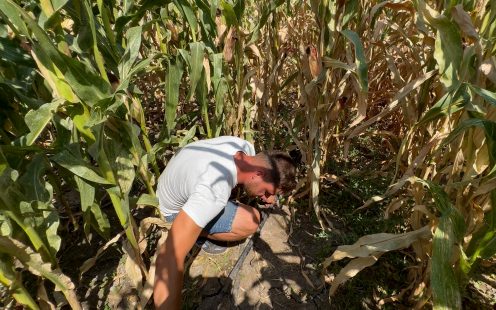.jpg)
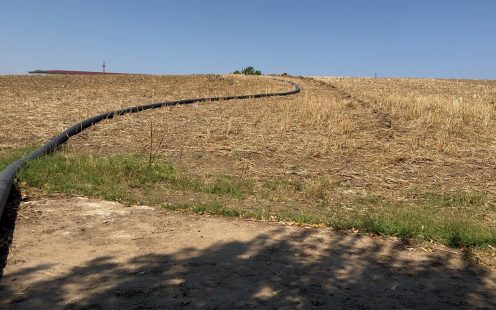.jpg)
Agricultural business of nearly 30 years focused on sustainable farming
Lux Com SRL is an agricultural company situated in Calarasi County, Southeast Romania. Specializing in oilseed and grain farming, the business was founded in 1997 and now cultivates over 8,000 hectares of land.
Corn farming plays a significant role in Lux Com’s operations, with over 300 hectares of maize planted in 2023. While sprinkler irrigation remains the most wisely used corn irrigation method in Romania, the technology is not without drawbacks, especially when it comes to relatively high energy and water consumption. A recent drop in corn prices has led many Romanian farmers to seek more cost-effective irrigation technologies to maintain competitiveness.
Case study: Drip irrigation system tested amid a major heatwave
In the summer of 2023, Lux Com decided to test precision irrigation on a 15-hectare field planted with flour corn. The system was installed in mid-June, allowing plants to develop deeper root systems before irrigation began. The field was divided into five 3-hectare sectors, each watered in turn for a period of one hour.
Mitran Marian, Agricultural Engineer at Lux Com, explains that improving water efficiency was a key factor behind the test, as his country has faced increasingly severe and prolonged droughts in recent years:
"Our water supply comes from the [nearby] river. The biggest advantage of drip irrigation over pivot is that nearly 100% of the water reaches the plants, whereas with pivot, there is a margin of evapotranspiration."
Recent summers in Romania have brought minimal rainfall and record-breaking heatwaves, with temperatures soaring above 40°C in the shade — exposing another drawback of sprinkler irrigation. In extreme heat, the droplets of water landing on leaves and flowers can burn the plants, affecting their growth and, ultimately, the yields. Marian refers to the phenomenon as 'the magnifying glass effect':
"With pivot irrigation, there's a risk of plant burns on very hot days. This summer, temperatures exceeded 40°C, but we couldn’t shut down the pivot system because restarting it would take days. I can't say we've had big losses, but there was no pollination at the top of some plants. With drip irrigation, it doesn't matter. Even at very high temperatures, you don't have this headache."
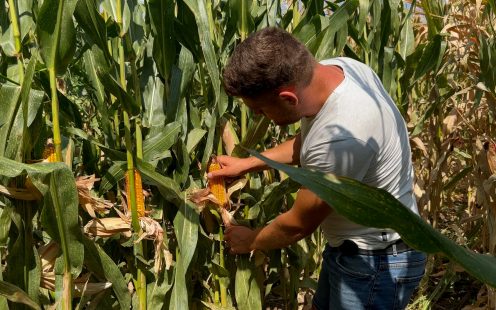.jpg)
Drip irrigation vs. sprinklers: Comparing the corn yields and profits
Since the drip irrigation system was installed on a flour corn field while sprinklers were used to water sweet corn, Marian notes that the yields cannot be directly compared. However, he confirms that both irrigation methods proved significantly more effective than rainfed cultivation.
With extreme heat and minimal rainfall throughout the summer, non-irrigated corn fields produced only ~1 t/ha on average. In contrast, flour corn irrigated via drip irrigation yielded 7.5 t/ha, while sweet corn irrigated with sprinklers averaged ~9 t/ha. Nearby drip-irrigated corn fields in Calarasi County achieved yields up to 14 t/ha, depending on factors such as corn variety, soil conditions and environmental influences.
“Flour corn and sweet corn are different maize varieties with different market prices. This season, flour corn was priced around 100 euros per ton higher. In addition, the sprinkler system had higher operating expenses as it’s fueled by diesel and requires more water. All factors considered, the drip-irrigated flour corn brought in more profit.”
Due to crop rotation requirements and a drop in maize prices, Lux Com plans to focus on wheat production this season. However, the company expects to return to maize cultivation in the future and is positive about using precision irrigation at a broader scale:
“While setting up a drip system requires more work than pivots, precision irrigation remains the more economical and future-proof choice.”
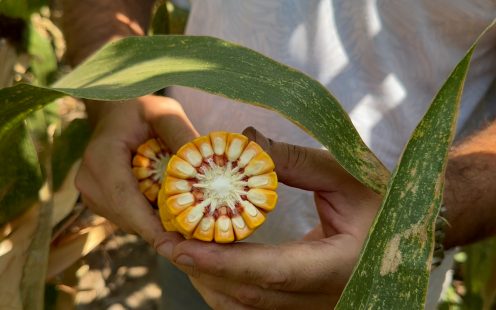.jpg)
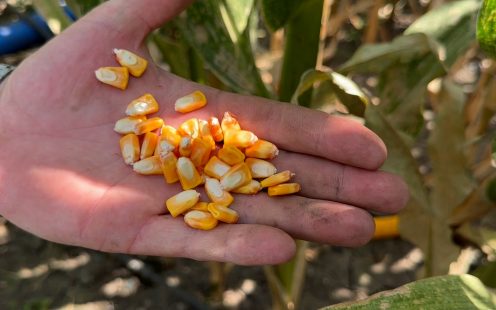.jpg)
Overview: Advantages of drip irrigation for corn farming
Drip irrigation offers numerous advantages over conventional irrigation methods, providing a sustainable solution for corn cultivation.
Improved crop yields and quality
By delivering water directly to the root zone, drip irrigation ensures that plants receive a constant amount of water and nutrients, which can be optimized per crop type to ensure maximum yields. Improved growth conditions also make crops more resilient to disease.
Reduced operating costs
Drip irrigation prevents water waste by minimizing evaporation and runoff. This method also decreases the reliance on fertilizers and pesticides, as the precise application to the root zone reduces nutrient leaching. By using less water, energy and fertilizers, corn farmers can make their operations more efficient and achieve significant cost savings.
Suitability for challenging field topography
Drip irrigation system design can be tailored to various crops, soil types and topographies, making the method suitable for diverse farming conditions. Pressure-compensating drip emitters and lines are used to equally distribute water and nutrients across an entire field, regardless of variations in terrain. Subsurface drip irrigation uses underground drip pipes to provide water directly to plant roots, further minimizing evaporation.
Support for sustainable agricultural practices
Precision irrigation systems save up to 65% of water usage compared to conventional methods. Drip irrigation also promotes soil health and minimizes leaching, making the method attractive for eco-conscious farmers.
Automation possibilities
Smart drip irrigation systems are now increasingly used as they ensure even higher watering consistency and save time. By enhancing a drip irrigation kit with sensors and controllers, it becomes possible to react to weather forecasts, changes in air humidity and soil conditions in real time, adjusting water delivery accordingly.
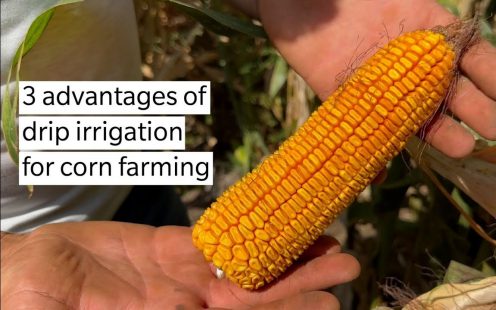
Find out more about
Get in Touch
Please choose your preferred way to get in contact with us. We will get back to you as soon as possible.
Fill our form